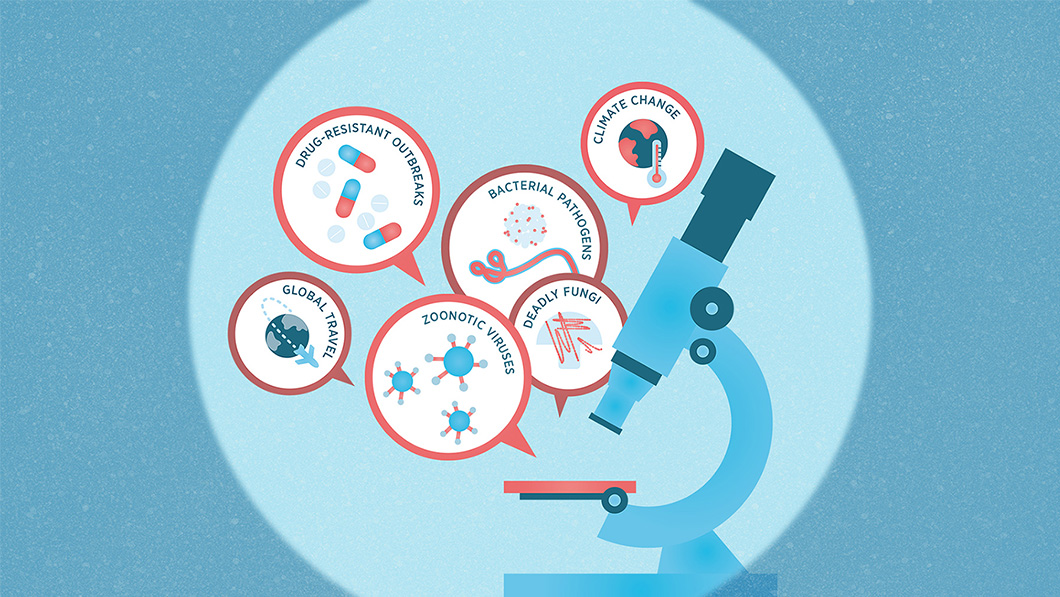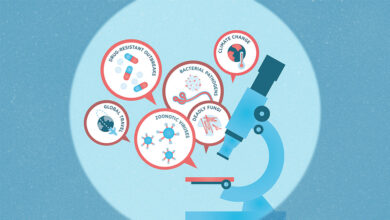
A ministry of health security, air quality ills and more measles
Sponsored by:

PPF’s report The Next One: Preparing Canada for another health emergency outlines the lessons learned from the pandemic and how Canada can safeguard against future health emergencies. To keep the discussion going — and to keep Canadians informed — this newsletter looks at what’s happening in the world of health security each week. Here’s what we’re following:
Pandemic comms
The U.S. State Department has launched the Foreign Ministry Channel (FMC) for Global Health Security to “serve as a platform for foreign ministries to focus diplomatic attention and action on critical global health security.”
In a statement announcing the launch, the State Department cited the critical gaps in cooperation, coordination, communication and collaboration revealed by the pandemic as motivating factors to work together more closely. The FCM launch included representatives from Australia, Bangladesh, Canada, Finland, France, Germany, India, Indonesia, Japan, Morocco, Norway, South Korea, Saudi Arabia, South Africa, Spain, Sweden, Thailand, the U.K., the EU and the Association of Southeast Asian Nations.
“A changing climate, growing regional instability resulting in mass movements of people, and the rise of misinformation and disinformation — which can be exacerbated by emerging technologies like artificial intelligence (AI) — further increase the complexity of preventing and responding to the next pandemic —the risk of which is ‘high,’” the State Department stated.
Indeed, the U.S. is already among those nations that is perhaps even less prepared “in a big picture way” for the next pandemic, Céline Gounder, a senior fellow at health policy nonprofit KFF told Axios this week.
Among the factors that have weakened America’s potential for responding to, and dealing with, another pandemic, are a depleted health workforce and a significant rise in skepticism of both health experts and vaccines. Crucially, the Pandemic and All-Hazards Preparedness Act (PAHPA) has yet to be reauthorized (as it is every five years).
In an op-ed in The Hill, Kathleen Sebelius, the former U.S. secretary of Health and Human Services, and Anita Cicero, deputy director of the Johns Hopkins Center for Health Security, urged the bill’s passing, arguing that it not only “keeps the regular programmatic machinery necessary for pandemic response working,” but would add key new supports to better prepare the U.S. for future trouble, including research and development, improved surveillance through data sharing, and better diagnostic testing capabilities.
Air quality declines
The latest IQAir World Air Quality Report released on Wednesday shows that Canada had worse air quality than the U.S. for the first time in the report’s six years of tracking. The report was based on data from more than 30,000 air quality monitoring stations worldwide measuring fine particulate matter. Canada was the most polluted country in North America in 2023 and ranked 93rd in the world for air pollution. Only seven nations met the World Health Organization’s air quality guidelines — Australia, Estonia, Finland, Iceland, Grenada, Mauritius and New Zealand. Among the worst were Bangladesh, Pakistan, India, Tajikistan and Burkina Faso.
The main driver of Canada’s bad air in 2023 was smoke from wildfires exacerbated by climate change. But health risks from poor air quality exist even if the skies aren’t darkened by wildfire smoke. The WHO estimates that the combined effects of ambient air pollution and household air pollution are associated with 7 million premature deaths every year.
One study of U.S. adults aged 65 and over between 2000 and 2016 concluded that exposure to fine particulate matter contributed to higher hospitalization rates for seven major types of cardiovascular disease. In February, the European Parliament and the EU’s member states agreed to strengthen air quality standards, setting new rules for air quality for 2030 that will be closer to the WHO’s target. The EU estimates that pollution caused by fine particulate matter led to more than 250,000 deaths in the EU in 2021, and that from nitrogen dioxide (NO₂) resulted in 52,000 deaths.
Homeland biosecurity
The U.S. military is worried about its ability to access key medications. In a new report, the U.S. Department of Defense (DoD) says it has a “high dependence on foreign material and trade agreements to maintain current pharmaceutical capabilities.” In all, the DoD found that 54 percent of its pharmaceutical supply chain is considered either high or very high risk, with dependency on non-Trade Agreement Act compliant suppliers, sourcing from China and India, or unknown.”
Breaking that down further, the DoD noted that five percent of essential drugs in its supply were made from active ingredients from China, while another 22 percent were made from ingredients from countries it couldn’t identify. A quarter of the DoD’s supply is domestic, while about three percent is from either Canada or Mexico.
The DoD report comes months after President Joe Biden invoked the U.S. Defense Production Act to enable the Department of Health and Human Services to increase investment in domestic drug manufacturing and improve supply chains. The U.S. has been hit with recurring shortages of antibiotics, as well as drugs for things like ADHD, diabetes and cancer over the past several months. But it’s not alone. Shortages are everywhere, including in Canada, where shortages have recently hit all time highs.
Meanwhile, the U.S. FDA issued a safety communication this past week regarding problematic syringes manufactured in China. The FDA also sent warning letters to manufacturers and distributors of the faulty syringes. According to NBC News, customers and physicians have said they’ve found “foreign matter” in some syringes, or have had needles break in the vials when drawing vaccines. Other syringes were reportedly cracked, delivered medications too fast, or made it difficult to measure the correct dosage.
Measles alerts
As another measles case surfaced this past week in the Toronto area, Canada faces a measles vaccine shortage. Both makers of the measles (MMR) vaccine — Merck Canada and GSK —have flagged to Health Canada that while they are “able to fully meet demand” for routine childhood immunizations, people who aren’t eligible for a publicly-funded vaccine will struggle to find one in the near future.
This week, the WHO’s director of immunization, Kate O’Brien, urged people around the world to update their measles vaccinations, noting that more than 50 countries have experienced “large and disruptive” outbreaks in the past year — twice as many as in 2022. That message was echoed by the Center for Disease Control this week in a health alert that outlined vaccine recommendations for educators, physicians and anyone planning to travel abroad.
In the same note, the CDC said it has recorded 58 confirmed cases of measles across 17 jurisdictions —equaling the total number of cases across the U.S. in 2023. Most of those cases have been in unvaccinated kids over 12 and linked to international travel.
UPCOMING ON 11 APRIL: Annual Testimonial Dinner Honour Roll 2024
Join more than 1,200 leaders and policy wonks as PPF pays tribute to Canadians who have made outstanding contributions to public policy and good governance. This year’s dinner takes place at the Metro Toronto Convention Centre — in the biggest dining room you’ve ever seen! Be in the room where it happens.
Treaty trouble
The fate of the WHO’s Pandemic Treaty hangs in the balance as disagreements between developing and developed nations continue. The agreement ostensibly aims to bring equity in access to health care and the tools countries need to fight pandemics.
The latest draft of the agreement was circulated earlier this month and negotiations on the final text resumed this week in Geneva, Switzerland. Talks have now stalled. The current revised draft has “not been matured,” one WHO representative said this week, and there is no timeline for an updated version.
A key sticking point is the proposed Pathogen Access and Benefit-Sharing (PABS) system, which would compel countries to share pathogen sequence information and samples. (The treaty would also compel manufacturers of “pandemic-related products” — vaccines, PPE, therapeutics — to provide 10 percent to the WHO free of charge and another 10 percent at a discount.) Many developed nations have pushed back against the requirements, while developing nations continue to argue that the PABS system doesn’t go far enough.
But some think it would be better to pass the treaty than not. “This treaty fills a lot of gaps and is really important because it builds trust between countries about setting expectations and norms,” Alexandra Phelan, a global health specialist at the Johns Hopkins Center for Health Security, told Science this week. “If it fails, it says we’re going to look at COVID-19 and say that was OK.”
Events
March
- March 26-28: Precision Med TRI-CON. San Diego, CA
April
- April 1-4: World Vaccine Congress. Washington, D.C.
- April 3: Advancing U.S.-Canada Life Sciences Cooperation. Washington, D.C.
- April 15-17: Festival of Biologics. San Diego, CA.
- April 15-17: Bio-IT World Conference & Expo. Boston, MA
- April 17-18: CMO Summit 360. Boston, MA.
- April 23-24: Public Health 2024. Halifax, NS.
- April 23-29: Intergovernmental Negotiating Committee (4th session). Ottawa, ON.
May
- May 12-14: Bio€quity Europe. San Sebastián, Spain.
- May 13-16: AAPS 2024 National Biotechnology Conference. San Francisco, CA.
- May 13-17: PEGS Boston. Boston, MA.
Did someone forward you this newsletter? Subscribe to PPF: Health Security newsletter
This newsletter is produced by journalists at PPF Media. It maintains complete editorial independence.



